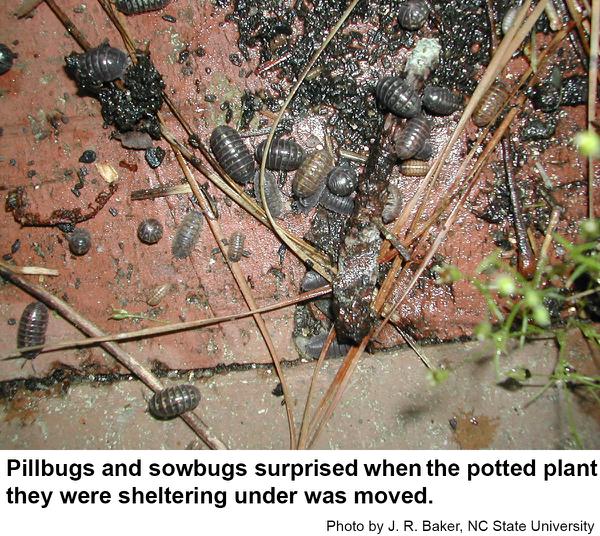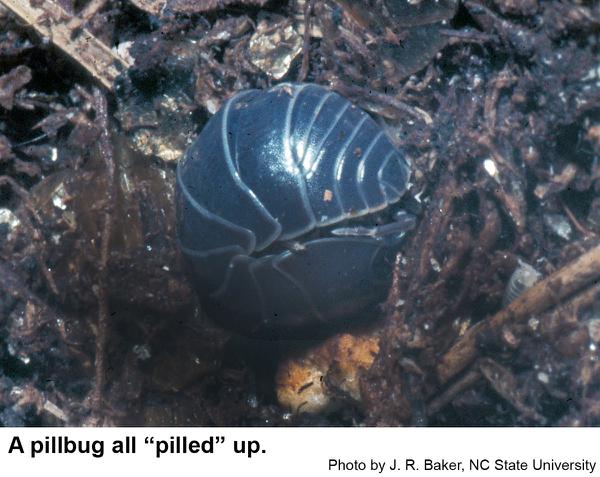General Information
Pillbugs, Armadillidium species, and sowbugs, Porcellio species, are small animals more closely related to lobsters than to insects. They breath through gills and tend to congregate in moist situations. Adult sowbugs and pillbugs are about 1⁄2 inch long, gray and oval. Sowbugs are flattened and have two tail-like structures on the rear end of the body that pillbugs do not have. Although sowbugs resemble pillbugs (roly-polies), sowbugs cannot roll up into a ball.
Biology
A female pillbug or sowbug carries her eggs in a pouch for several weeks until they hatch. The young remain in the pouch up to two months. About 50 young develop in each brood and mature in about a year. They breed mainly in the spring and may live up to three years and have up to three broods.
Sowbugs and pillbugs feed on decaying vegetation and sometimes tender vegetation. They breathe by means of gills and live under vegetable debris and other objects lying on damp ground. They are sometimes found in damp basements and crawl spaces, but they do no structural damage. They die soon and may be swept up. Large numbers of sowbugs or pillbugs in a basement or crawling in the upper part of a house usually means an abundant number outside.
Although primarily scavengers, during wet weather, sowbugs and pillbugs may come indoors and seek refuge under and in potted plants where they might damage roots if abundant. Occasionally, sowbugs and pillbugs feed on the roots and tender portions of vegetable and ornamental plant seedlings outdoors. They feed mostly at night.
Control
Rake all debris away from the foundation of buildings occasionally. Plug the foundation and around window frames with caulking compound or other material. Keep basements dry by cross ventilation during the summer. Keep the area free of rotting wood, decaying vegetable matter, soil and other materials that provide food and hiding places for sowbugs and pillbugs. Keep windows tightly screened during ventilation.
Treatments should be made to and near foundation walls, around and beneath door steps and porches, subfloor crawl spaces, damp basements and similar areas immediately adjacent to the building. The outdoor application of chemicals should extend to at least 10 feet around the structure being protected. Any of the outdoor lawn and garden products labeled for these arthropods or one of the following chemicals may be used.
| Pesticide | (Trade Name) | Formulation |
|---|---|---|
| acephate | (Orthene) | 75% soluble powder |
| cyfluthrin | (Decathlon) | 20% wettable powder |
| cyfluthrin | (Tempo 2) | 24.3% emulsifiable concentrate |
| bifenthrin | (Talstar) | 10% wettable powder |
| carbaryl | (Sevin) | various |
Many "all purpose" insecticides off the shelf are effective and suitable for home use. Check the label! When used as directed, pyrethroids are very toxic to insects but are not particularly hazardous to humans and pets (other than fish—avoid using pyrethroids around pools, ponds, and streams).
Other Resources
- "Armadillidium vulgare" Holland, A. 2014. (On-line), Animal Diversity Web. Accessed July 16, 2018
- Common name: pillbug, roly-poly, woodlouse; scientific name: Armadillidium vulgare (Latreille) (Malacostraca: Isopoda: Armadillidiidae). Franklin, J. A., M. A. Byron, and J. Gillett-Kaufman. 2015. Featured Creatures, Entomology & Nematology, FDACS/DPI, EDIS. Publication Number: EENY-630.
- Pillbugs and Sowbugs. Bechinski, E. J. and F. W. Merickel. 2009. University of Idaho Extension.
- Sowbugs and Pillbugs. Anonymous. No date. Missouri botanical Garden Gardening Help.
- NC State Extension Plant Pathology Publications
- NC State Horticultural Science Publications
- North Carolina Agricultural Chemicals Manual
For assistance with a specific problem, contact your local N.C. Cooperative Extension center.
Publication date: May 1, 1997
Reviewed/Revised: Nov. 16, 2020
Recommendations for the use of agricultural chemicals are included in this publication as a convenience to the reader. The use of brand names and any mention or listing of commercial products or services in this publication does not imply endorsement by NC State University or N.C. A&T State University nor discrimination against similar products or services not mentioned. Individuals who use agricultural chemicals are responsible for ensuring that the intended use complies with current regulations and conforms to the product label. Be sure to obtain current information about usage regulations and examine a current product label before applying any chemical. For assistance, contact your local N.C. Cooperative Extension county center.
N.C. Cooperative Extension prohibits discrimination and harassment regardless of age, color, disability, family and marital status, gender identity, national origin, political beliefs, race, religion, sex (including pregnancy), sexual orientation and veteran status.



